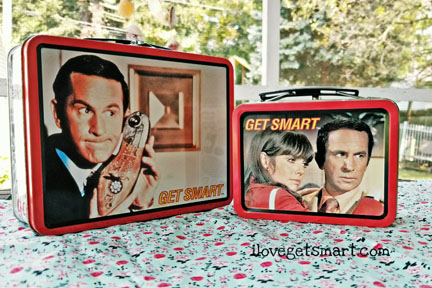
Trent: If you've got to hold on from something
from the sixties, peace and love sure beats a Get Smart lunch box
Daria: Especially if the lunch is still in it.
-from MTV's Daria
I have news for Trent, happiness is
a Get Smart lunch box. One of my goals in recent years, by the way,
was to get my mitts on an original Get Smart box. Ok, I may need to re-evaluate my life
plans, but nevertheless, I finally got a box! It is not the world's
greatest GS box, but it is still a box. Therefore, the time is
right that I should pay a homage to the picture-riffic world of lunch boxes.
The
Original Get Smart Lunch Box
 |
I think the neat thing about the original
box is that it has such awesome graphics. The bottom of the box has a
scene from "Mr. Big" on it, while the top has Max and the Chief under the Cone
of Silence. Kudos to such great art goes to lunch box artist Nick LoBianco.
Aside from painting lunch boxes, Mr. LoBianco also designed the famed Monkees'
guitar logo in 1966.
Made in 1966 by King Seeley, the original
Get Smart lunch box can be a tad pricey depending on what shape the box is in and whom it's being
bought from. Hence, Ebay
auctions on these puppies really do get ridiculous. I saw a near mint one
on auction for *cough* $185! However, used boxes go for cheaper -usually
being on the underside of $100.
One should watch their pocket book and use
sense when considering buying a box. I once saw a Get Smart box in an antique
mall for $35. That was all very well and good, but Max's face was nothing
but a big
brown rust spot! Ugh!
I elaborated more on the Get Smart lunch box and
lunch box pricing in this
article on my blog.
|
The Thermos
 |
Issued the same year, and by the same
people, the Thermos features the scenes from the back of the original box:
99 is tied up and Max is shooting at killers that oddly resemble a pack of Dr.
Evil clones.
The Thermos above has a replacement top as the original one
is supposed to be red, not beige. A big problem with these types of Thermoses is
that they broke if they were dropped enough times, hence the need for
replacement parts.
A near mint price is roughly
around $88, but a used one can go for as little as $15. |
The
"Collectible" Tins
 |
Collectible tins are not lunch boxes -or so
the purists say. They are, however, pretty nifty additions to any GS
collection and are reasonably cheap.
The box at left is a mini tin
and goes for around $7 and the box at right is a full size tin (full size does
not mean it's as roomy as the '66 model, though) and runs about $10.
These boxes first appeared in 2000 and also make nifty purses. They're not as
easy to find as the original lunch box -especially that smaller one. |
The Key
Chain
 |
That's the second smallest lunch box I've
ever seen!
The key chain lunch box, which first graced the world with its
presence in 1998, not only holds keys, but can also be used as a handy dandy
pill box. The design is red plastic with the same images from the 1966
box.
Fun and nutritious bonus: the key chain comes with a Get Smart
a mini Thermos and a plastic fruit snack. It's either an apple or a banana. Yummy.
These don't show up for auction as much as they used to, so prices
can range. |
How to Treat a
Box:
Boxes should be treated with kid gloves! The number one lunch
box enemy is
water! Do not take Mr. Lunch Box for a swim because he'll rust! The
number two enemy is a damp environment that promotes rust. Basements,
garages, and tool sheds are not good places for metal boxes. The number
three enemy is direct sunlight due to the fact that the images on the box will
fade. It's best to keep the box away from the old bay window's line of
fire not only to prevent fading, but also to keep it from rusting.
Fun Facts:
The first metal box was 1949's Hopalong Cassidy.
Carrying a colorful box featuring the coolest cartoon or TV show of the year has
always been the in thing for elementary kids to do. Therefore, the
Hopalong Cassidy lunch kit led to a trend spanning five decades.
The fond days of metal lunch boxes ended in 1987 when King
Seeley cut production on the last metal box, Rambo.
Allegedly, the production of metal boxes ended not
because a metal Popples Box (1986) couldn't compete with a plastic Rainbow Brite
box (1983), but because in 1972 a group of mothers complained that the metal
boxes were hazardous and pressed Florida state legislature for a ban such lunch
boxes. The claim was that kids could hurt themselves by bonking each
other on the head with the metal boxes. This ruling on metal lunch boxes, however is appearing to be more myth than reality as actual proof of
such a law is yet to be found.
COPYRIGHT © 1999-2023 BY AMANDA
HAVERSTICK.
|





